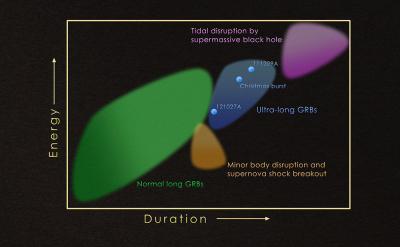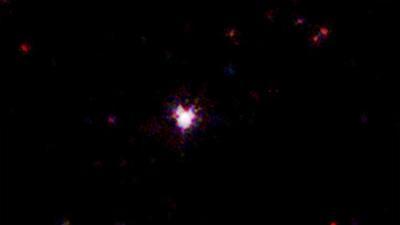"We now know that the Christmas burst occurred much farther off, more than halfway across the observable universe, and was consequently far more powerful than these researchers imagined," said Andrew Levan, an astronomer at the University of Warwick in Coventry, England.
Using the Gemini North Telescope in Hawaii, Levan and his team obtained a spectrum of the faint galaxy that hosted the Christmas burst. This enabled the scientists to identify emission lines of oxygen and hydrogen and determine how much these lines were displaced to lower energies compared to their appearance in a laboratory. This difference, known to astronomers as a redshift, places the burst some 7 billion light-years away.
As a part of this study, which is described in a paper submitted to The Astrophysical Journal, Levan's team also examined 111209A and the more recent burst 121027A, which exploded on Oct. 27, 2012. All show similar X-ray, ultraviolet and optical emission and all arose from the central regions of compact galaxies that were actively forming stars. The astronomers conclude that all three GRBs constitute a hitherto unrecognized group of "ultra-long" bursts.
To account for the normal class of long GRBs, astronomers envision a star similar to the sun's size but with many times its mass. The mass must be high enough for the star to undergo an energy crisis, with its core ultimately running out of fuel and collapsing under its own weight to form a black hole. Some of the matter falling onto the nascent black hole becomes redirected into powerful jets that drill through the star, creating the gamma-ray spike, but because this burst is short-lived, the star must be comparatively small.
"Wolf-Rayet stars fit these requirements," explained Levan. "They are born with more than 25 times the sun's mass, but they burn so hot that they drive away their deep, outermost layer of hydrogen as an outflow we call a stellar wind." Stripping away the star's atmosphere leaves an object massive enough to form a black hole but small enough for the particle jets to drill all the way through in times typical of long GRBs.
Because ultra-long GRBs persist for periods up to 100 times greater than long GRBs, they require a stellar source of correspondingly greater physical size. Both groups suggest that the likely candidate is a supergiant, a star with about 20 times the sun's mass that still retains its deep hydrogen atmosphere, making it hundreds of times the sun's diameter.

GRB 101225A, better known as the "Christmas burst," was an unusually long-lasting gamma-ray burst. Because its distance was not measured, astronomers came up with two radically different interpretations. In the first, a solitary neutron star in our own galaxy shredded and accreted an approaching comet-like body. In the second, a neutron star is engulfed by, spirals into and merges with an evolved giant star in a distant galaxy. Now, thanks to a measurement of the Christmas burst's host galaxy, astronomers have determined that it represented the collapse and explosion of a supergiant star hundreds of times larger than the sun.
(Photo Credit: NASA's Goddard Space Flight Center Scientific Visualization Studio)
Gendre's team goes further, suggesting that GRB 111209A marked the death of a blue supergiant containing relatively modest amounts of elements heavier than helium, which astronomers call metals.
"The metal content of a massive star controls the strength of its stellar wind, which determines how much of the hydrogen atmosphere it retains as it grows older," Gendre notes. The star's deep hydrogen envelope would take hours to complete its fall into the black hole, which would provide a long-lived fuel source to power an ultra-long GRB jet.
Metal content also plays a strong role in the development of long GRBs, according to a detailed study presented by John Graham and Andrew Fruchter, both astronomers at the Space Telescope Science Institute in Baltimore.
Stars make heavy elements throughout their energy-producing lives and during supernova explosions, and each generation of stars enriches interstellar gas with a greater proportion of them. While astronomers have noted that long GRBs occur much more frequently in metal-poor galaxies, a few of them have suggested that this pattern is not intrinsic to the stars and their environments.
To examine this possibility, Graham and Fruchter developed a novel method that allowed them to compare galaxies by their underlying rates of star formation. They then examined galaxies that served as hosts for long GRBs and various types of supernovae as well as a control sample of 20,000 typical galaxies in the Sloan Digital Sky Survey.
The astronomers found that 75 percent of long GRBs occurred among the 10 percent of star formation with the lowest metal content. While the study found a few long GRBs in environments with high-metal content, like our own galaxy, these occur at only about 4 percent the rate seen in low-metal environments per unit of underlying star formation.
"Most stars form in metal-rich environments, and this has a side effect of decreasing the prevalence of long GRBs as the universe grows older," Graham explained. "And while a nearby long GRB would be catastrophic to life on Earth, our study shows that galaxies like our own are much less likely to produce them."
The astronomers suspect this pattern reflects a difference in how well a massive star manages to retain its rotation speed. Rising metal content means stronger stellar winds. As these winds push material off the star's surface, the star's rotation gradually decreases in much the same way as a spinning ice skater slows when she extends her arms. Stars with more rapid rotation may be more likely to produce a long GRB.
Graham and Fruchter hypothesize that the few long GRBs found in high-metal environments received an assist from the presence of a nearby companion star. By feeding mass -- and with it, rotational energy -- onto the star that explodes, a companion serves as the physical equivalent of someone pushing a slowly spinning ice skater back up to a higher rotational speed.

Three recent GRBs (blue dots) emitted high-energy gamma-ray and X-ray light over time spans up to 100 times greater than typical long bursts and constitute a new ultra-long class. This plot compares the energy received and the event duration among different classes of transient high-energy events: long GRBs (green); the disruption of an asteroid or comet by a neutron star or stellar-mass black hole in our own galaxy, or the break-out of a supernova shock wave in another galaxy (orange); and the tidal disruption of a star by a supermassive black hole in another galaxy (purple).
(Photo Credit: NASA's Goddard Space Flight Center, after B. Gendre (ASDC/INAF-OAR/ARTEMIS))

GRB 111209A exploded on Dec. 9, 2011. The blast produced high-energy emission for an astonishing seven hours, earning a record as the longest-duration GRB ever observed. This false-color image shows the event as captured by the X-ray Telescope aboard NASA's Swift satellite.
(Photo Credit: NASA/Swift/B. Gendre (ASDC/INAF-OAR/ARTEMIS))
Source: NASA/Goddard Space Flight Center